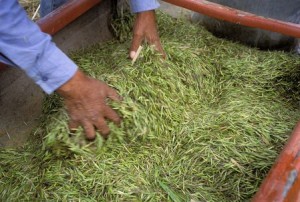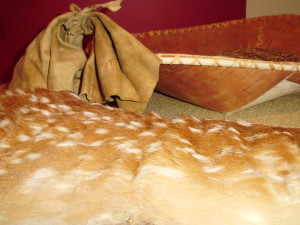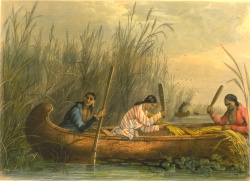Thousands of years ago, according to oral histories, the Anishinaabeg, or Ojibwe, followed a shell in the sky from the great waters of the East to “the place where the food grows on the water.” That food was wild rice, the only grain indigenous to North America. Wild rice has been a central food in ceremony and sustenance for Native people ever since.
“The[y] gain their livelihood by fishing, hunting, gathering berries and wild rice and making maple sugar, which constitutes their chief means of support,” European traders would write. These same traders came to depend on wild rice as the source of their own sustenance.
Provisioning the laboring classes was the responsibility of the fur trade companies. During periods of travel like the fall expedition into the interior and the spring return trip to headquarters, corn figures most prominently. But during the long days of winter, wild rice was critically important to the traders and their crews for survival.
During the British fur trade period, we can tease out a pattern of reliance upon wild rice from the contemporary journals of George Nelson and Michel Curot of the XY Company, and Francois Malhiot and John Sayer of the North West Company . . .
North West Company man Daniel Harmon describes the vital importance of what he termed “oats.” This grain is gathered in such quantities, in this region, that in an ordinary seasons, the North West Company purchase, annually, from twelve to fifteen hundred bushels of it from the natives; and it constitutes a principal article of food, at the posts in this vicinity. (111)
In good years, an Indian family could rely upon the rice harvest for sustenance as well as trade any surplus. Notes Nelson, Some families I have been told make as much as 40 & even 50 bushels in some seasons, and I do believe it (151-2).
Rice was doled out to the men in proportions similar to corn. Nelson describes The allowance is one quart, with two ounces of grease, (when we have it) to season it, to each man. It is pleasant & good, but is not very nourishing (151-2).

Photograph by Bob Sacha from the article “Ricekeepers” by Winona LaDuke, Orion magazine, https://orionmagazine.org/article/ricekeepers/
Nelson learned the strategic value of the rice harvest, and the severe disadvantage of the lack of it. In September 1802, as he ventured deeper into the XY’s Folle Avoine department, his boss paused to hire an Indian man, his wife and son to make a canoe. He told us that the N.W. people had passed up long since & had no doubt bought up all the wild rice &c. (148)
Indeed, as Nelson later notes, The N.W. Co, having arrived early in the season, had collected all the rice long before we arrived, & with the meat they occasionally got from the indians they lived well [George’s emphasis]. It was not so with us: we were often sorely pinched. (229)
Bad luck struck another XY trader the following year as he headed to the Yellow River. Just days into the new fiscal year, as Michel Curot’s company of men approached Fond du Lac, a rolling surf pulled cargo from his canoes. Despite a desperate scramble, two bags of corn were lost. He requisitions more corn from headquarters by way of a later canoe. (398-9) Upon re-arrival at Fond du Lac the following spring, Curot is issued this belated sack of corn, which, with catches of fresh fish, powers his men’s ascent to Grand Portage where they arrive by mid summer. (469)
That shortage of corn in fall 1803 was unfortunately an early indication of a long year of trouble ahead for Curot. While ascending the Brule, before reaching their wintering post on the Yellow River, one of Curot’s men insists on Two Pints of Corn Per Day. Curot counteroffers a smaller amount, a Chopine of Corn for the Smith children, but is refused (400).
Whether wives and children should receive company rations remains a bone of contention all season among Curot’s men. By November, another of Curot’s men is quibbling that three Chopines parched Rice is an inferior equivalent to Two Chopines roasted rice. (440)
Despite rumors of a poor harvest, Curot manages to trade for and cache twenty “fans” of wild rice to supplement his now limited supply of corn. By February, his stockpile is running low. That month, he trades a 2-1/2 point blanket to a local woman who brings him another skin of rice. Worse, he notes, this month the fish do not bite… (442)
By early March, Curot’s men are on half-rations. His competition next door at the NWCo post are no better off. John Sayer notes he has no more than one fawn-skin of rice to supply 6 Men and Two clerks. And when the fish start biting in late March, the grease for frying is long gone. (450)
In 1803, the sparse rice harvest in the Folle Avoine region translated into a limited supply with which to provision company departments for the 1804-05 trade year. NWCo trader Francois V. Malhiot was assigned to head up the Lac du Flambeau region, and his provisions included 18 bushels of Corn and only 1 1/3 [of] wild rice. (222)

Rice storage containers on display at North West Company Fur Post, Pine City. The spotted container is literally a fawn-skin taken off nearly whole for use as rice sack. Sometimes written in fur trade records as a “fan” (“faon” is the French word for “fawn”), these versatile containers had an average capacity of two bushels. English speakers like Sayer refer to it as a “bag of oats,” but fans were first mentioned by Jonathan Carver in his Travels published in London in 1781. Similarly, grease was often traded in bladders; the grease from processing a slaughtered animal was packed and stored in the animal’s own seamless bladder.
Fortunately, the 1804 harvest was ample and Malhiot was able to take advantage of a good season. Throughout his daily journal Malhiot describes many examples of useful seasonal items obtained in trade, including wild rice, fresh meat, corn and pumpkins in August; wild rice and fresh meat in September; fish and corn in November; snowshoes in December, bear grease in February; grease, corn and meat in March; maple sugar in April, and a canoe in May.
During a particularly rainy stretch in September 1804, with the fishing nets not able to be set and the hunt less than productive, Malhoit complains of the monotony of his rations …we constantly eat our rice with water only. A fine and good dish! dogs would get thin on it. (198)
Further evidence of a plentiful harvest appears in John Sayer’s journal from his 1804 wintering post on the Snake River. Sayer’s men traded for no less than fifty-seven bags of “oats” between mid-September and mid-October, caching them in several locations along the Snake River. Not all of the caches successfully preserved their contents, but from Sayer’s point of view, what a difference a year made!
Deep in January of 1805, Sayer notes that he is tapping his caches of precious “oats” to offer up as daily rations. By March he is distributing rice to supply his sugaring crews, as well as providing a bagful to a clerk so the latter can travel to Fort St. Louis.
By April, Sayer begins to tell of scarcity. He notes in his journal, our provision begins to be very Scarse [sic]. Sayer’s journal ends before he describes any preparations for his return to Grand Portage. Perhaps like Curot, he is able to replenish his men with corn at Fond du Lac.
Sources
Curot, Michel. “A Wisconsin Fur Trader’s Journal, 1803-4,” Collections of the State Historical Society of Wisconsin, 20:396-471, 1911.
Harmon, Daniel Williams. A Journal of Voyages and Travels in the Interior of North America. Courier Press. Toronto, 1911.
Malhiot, Francois V. “A Wisconsin Fur-Trader’s Journal, 1804-05,” Reuben G. Thwaites, ed., Collections of the State Historical Society of Wisconsin, 19:163-233, 1910.
Nelson, George. “A Winter in the St Croix Valley,” Richard Bardon and Grace Lee Nute, eds. Minnesota History 28(1):1-14; (2):142-159; (3): 225-240, 1948.
Sayer, John. John Sayer’s Snake River Journal, 1804-05. Birk, Douglas, ed. Institute for Minnesota Archaeology, Saint Paul, 1989.


Merci pour cet article